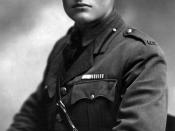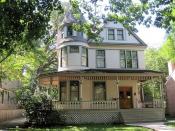Travelling On the Spiritual Desert ----A Thematic Analysis of Hemingwayáïs Hills Like White Elephants Ernest Hemingwayáïs Hills Like White Elephants is an example of a literary iceberg beneath the surface. The story consists mainly of a dialogue between a young woman and a man who are waiting for a train at a tiny station in the Spanish countryside. We learn that they have traveled widely, that they are intimate, and that they are lovers. But they are in conflict. The conflict that they bring out into the open and discuss aloud is concerned with an abortion. Gradually we realize that although the current conflict is over the abortion, there is a deeper and unspoken conflict. This more significant conflict---the main conflict---is over the nature of their relationship. The man does not want his lifestyle altered by a baby, thus considering an abortion the only realistic alternative. It will allow him to continue the rootless and uncommitted relationship he has enjoyed with the woman up to now.
So the man tries to reassure her of the operationáïs simplicity, but he fails to understand the emotional impact of an abortion on the woman, and this misunderstanding creates the underlying tension of the story. The woman, however, wants a more stable relationship, in the hope that it will be further affirmed by the child. Moreover, she has innocently believed that the man also wants this kind of relationship. Hemingway resolves the conflict by making the woman realize, in the face of the manáïs continued insistence on the abortion, that the relationship she wants with the man is impossible.
Throughout the whole story, the two characters are only identified as a áðmanáñ and a áðgirláñ. Though the words give some clues to show the tension between them at the very moment, they are far from enough to help us weave together the fabric of their past. Actually little information of the characters demonstrates that they are the general stereotypes of the young people of the time who are rather rootless, aimless and unpromising. Their empty relationship, the impersonalization of the war and their spiritual predicament----all these are the themes Hemingway intends to reveal in Hills Like White Elephants. He writes in a style using the minimum of words to express the maximum of meaning. The couple have been pursuing a lifestyle that is a sterile existence of the aimless hedonism. They kill love, deny their own possibility, and show themselves incapable of the affirmative, life-defining choice.
By a deceptively simple conversation, Hemingway presents a kind of duality---its blend of tenderness and tension, innocence and numbness. At the end of the story, the woman seems to compose herself by saying that she is áðfineáñ, but this apparently emotional response clearly betrays her inner despair and uncertainty of the future. Love was dead, as cold and lifeless as if it had never been. Their problematic relationship would not be solved or cured, even if the number of them (two instead of three) remains the same. Actually, the man and the woman can be any persons with the given problem in the given time. However, the common feature is that there is no hope of or solution to the problem of those travelling on the spiritual desert.
War is for Hemingway a potent symbol of the world, which he views as complex, filled with moral ambiguities, and offering almost unavoidable pain, hurt, and destruction. To survive in such a world and perhaps to emerge victorious, one must conduct oneself with honor, courage, endurance, and dignity, a set of principles known as "the Hemingway code." But this short story seems a self-critique of that code, of which we fail to find any trace. The man merely wants to experience the excitement of the life, so he regards the child as infringing upon his freedom. Living a restless life, he does not intend to shoulder any responsibility, let alone to show the áðgrace under pressureáñ. That they have been drifting here and there reflects a kind of unstable life they are living, and the roads that they are following will lead nowhere. Even the exile itself which began as an escape from the sterility of the American wasteland is doomed to end in another and greater sterility. Therefore, their ways of pleasure, adventure and dream only give rise to futility, confusion and despair.
Meanwhile, the railroad station setting actually parallels the thematic concerns of the story. It tells us something about the characters, their conflict, and the choice they face, thus pointing to the story's ultimate theme. Hemingway stresses three elements of the story's setting---the line of rails, the oppressive heat, and the contrasting sides of the valley---to indicate the nature of the couple's conflict and the difficulties of resolving it. The oppressive heat shows the couple's tension and suggests their inner anger. Also the thin line of rails represents the decision they must make. Even more effective than the emphasis on the rail line and on the heat, however, is the way Hemingway draws attention to the two starkly contrasting sides of the valley. Once again, an aspect of the story's setting helps reinforce the central conflict between its characters and the painful choice they must make. On one side the valley is lush with vegetation and vitality: a river flows serenely, trees stretch into the sky, and grain blows gently in the breezes. This side obviously symbolizes the life, which Hemingway seems to link with the girláïs desires to have the baby and settle down in a permanent and loving relationship. Nevertheless, the other side of the valley is just the opposite. Bleak, barren, and sterile, it is a desert landscape, lacking life or any hint of animation. This side represents the deadly consequences of the abortion, the meaningless nature of the couple's previous relationship and to be more important, their spiritual emptiness. Between the two sides is the train station. It is a place of greetings and farewells, a place where the lives change and shift, perhaps never to be the same. No matter what the couple decide to do, even their former superficial love, respect and caring will not survive. Subtly yet deftly, Hemingway uses this aspect of the story's setting to indicate something significant about its deeper meaning.
Hills Like White Elephants has the sound of tragedy, even if it is presented at somewhat great a distance for tragic impact. Not only can Hemingway describe life "as it is," but he is often more adept at describing life "as it is not." After all, life is not a bed of roses, a carefree world in which lovers walk hand and hand into a wonderful sunset. No, the sun also rises but if its rays are too hot or too bright or if it stays visible for too long, the roses will wilt and die. And Hemingwayáïs Hills Like White Elephants is just an exploration into the unknown territory of those deeper layers of awareness and unconsciousness. Beyond its crisp conversation, Hemingway reveals the empty relationship, the tragedies of life and human nature, and to be more important, the moral bankruptcy and spiritual sterility in the post First World War society.





